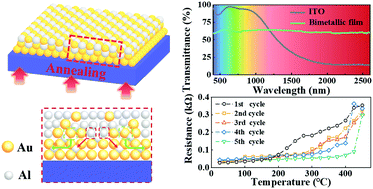Highly thermally stable Au–Al bimetallic conductive thin films with a broadband transmittance between UV and NIR regions†
Abstract
Metallic transparent conductive electrodes with broadband transparency have great potential for optoelectronic devices, and a huge challenge is to simultaneously maintain the conductivity and transparency of the metallic thin films at high temperatures. We demonstrate a facile method to fabricate transparent conductive Au–Al bimetallic thin films with excellent thermal stability up to 500 °C. With the existence of 10 nm-thick Al cap layers, the dewetting of the 10 nm-thick Au thin films is successfully suppressed owing to the formation of Au–Al alloys induced by the inter-diffusion of Al atoms. Owing to the formation of the Au–Al alloys, the conductivity of the bimetallic ultra-thin films was improved up to 7.9 Ω □−1, which is even superior to that of the as-deposited 20 nm-thick Au thin films. The Au–Al bimetallic thin films stably exhibit a high transmittance with an average value of ∼63% over a wide range between 350 and 2500 nm, which is higher than that of the commercial indium tin oxide (ITO) thin films with an identical resistance, especially for the regions above 1200 nm. The bimetallic thin films also have outstanding reliability after several cycles of annealing up to 500 °C, offering an effective route to overcome the limitation of transparent conductive thin films for optoelectronic devices working under harsh conditions, i.e. vacuum and high temperatures.



 Please wait while we load your content...
Please wait while we load your content...